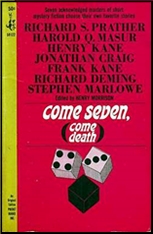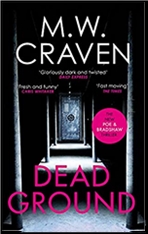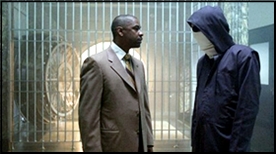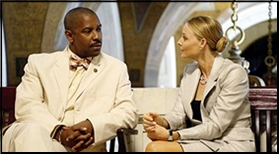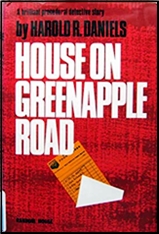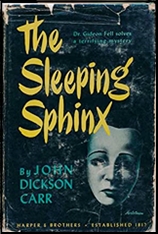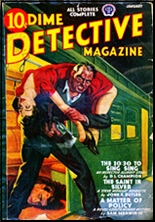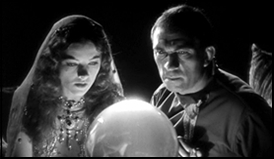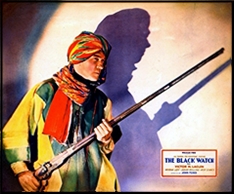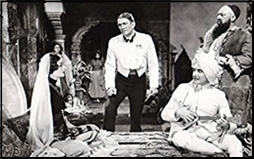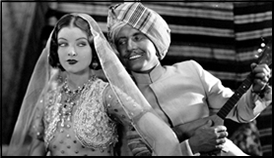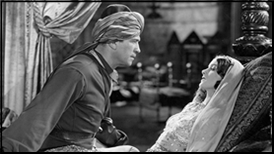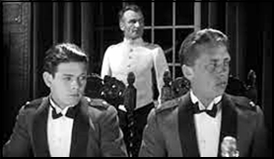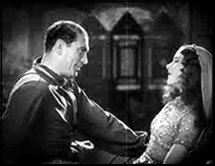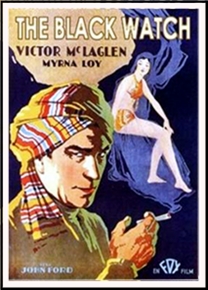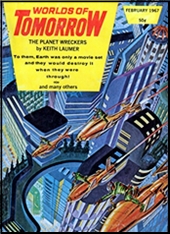REVIEWED BY TONY BAER:
DONALD HAMILTON – The Steel Mirror. Rinehart & Co., hardcover, 1948. Dell #473, paperback, mapback edition, 1950; cover by Robert Stanley. Gold Medal, d1617, paperback. Film: United Artists, 1957, as Five Steps to Danger.
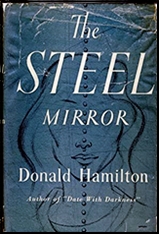
So, I know I’m supposed to read Donald Hamilton. And I know this isn’t the one you’re supposed to start with. But it’s one I happen to have in paperback. And we’re on vacation on the beach in North Carolina this week. And reading vintage Gold Medal’s on the beach, sitting on a lawn chair, with an ice cold can of beer, while one’s children run around building sand castles, jumping waves, flying kites and collecting shells, is one of the most truly wonderful experiences in the world.
And I’ve been meaning to read the guy. So, why not?
This man Hamilton can really write. And grab you. He’s really good.
Problem is, I’m not sure if in the end he has anything to say. Which is to say that, to me, it feels like the plot is just scaffolding to hold terrific prose.
In terms of plot, the book is pretty heavy on the postwar paranoia Russian spy angle. And that’s not really my bag. Though current events may bring this sub genre back into style.
John Emmett has a month off between jobs. He had a job in DC, but it was a temp job filling in for a returning soldier. He got a new job in Bakersfield and bought a cheap junker to take a slow meander cross country to his new gig.
Unfortunately it breaks down in Iowa. And the cost to fix it outstrips the value of the car. So he’s resigned to taking the train when an overheated pretty lady in an overheated car stops into the garage. When he finds out she’s heading west one of them picks up the other, it’s not clear which, and they head off in her convertible.
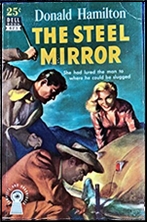
Turns out she’s recently come out of the loony bin, having PTSD from being held in a Nazi concentration camp as part of the French resistance. She has amnesia about whether or not she ratted out her resistance comrades, leading to their demise.
She finds out that a former co-prisoner is now a professor in Denver — so she’s headed there to try to fill in the blanks in her memory.
Unfortunately, Russian spies don’t seem to want her to meet the professor. And will do anything in their power to stop her from reaching her destination.
The story is pretty enthralling until you finish it. You turn the pages as quickly as you can. And then, by the end, you wonder why you wasted your time.
I mean it was fun and everything, I guess. But looking back it kinda reminded me of the ending of Neil Simon’s Murder by Death in which the murderer confesses at the end and then takes off mask after mask after mask, where by the end every single character has plausibly confessed.
It’s not quite as ridiculous as that. But the depth of supposed Russian double agent state infiltration runs so deep it makes McCarthyism seem understated.
Anywho, like I was saying, this Hamilton guy can really write. And one thing I really came to appreciate from the guy is how he makes setting descriptions a part of the story itself. He doesn’t use metaphor to show what a great poet he is. He uses it to advance the tension and move the story. Which is something too few writers do. Nothing makes me shut a book quicker than a cliched, unnecessary metaphor.
Let me illustrate just how good Hamilton is at this:
First take the title itself:
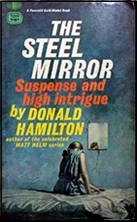
“Then I was back in my cell again. I tried to break the mirror with a bowl they had given me food in, so that I could use the splinters to kill myself, but the mirror was steel and wouldn’t break.â€
Protagonist confusion:
“Clouds were rising over the mountains to the westward, and the mountains themselves hidden behind the buildings across the street, but the sun was still bright and hot. He could not make himself think coherently.â€
The girl escapes capture, the protagonist wonders where she’s gone:
“Out on the street again, he found that the thunderhead in the west had reached its zenith, and as he walked away from the hotel the sun went behind it, leaving the air suddenly a little chilly.â€
Marching at gunpoint:
“He could see the lake as they came out, cold and metallic in the dark.â€
Racing thru the mountains, tailed by villains:
“The road climbed up to the ridge above Hogback Lake and followed it for a mile, the lake gleaming black in the darkness below and behind them; then plunged down into the canyon on the far side…. the headlight showed alternatively raw earth cutbacks, to the left; and to the right, the tops of small pine trees rising out of the darkness.â€
As the protagonist figures out a major clue in the mystery:
“The earth seemed to drop out of the beam of the headlights. He braked hastily and watched the light swing down to pick up the road again, where it plunged down the mountainside to the town of Summit, visible in the canyon below them as a cluster of lights. Emmett threw the gearshift into second, and let the car begin to grind its way down the hill under easy control.â€
The relationship between boy and girl starts to unravel:
“The sun was almost down when the road dipped to show them a barren plain below, broken by a series of garishly striped, eroded buttes that, Emmett thought, were good for nothing but putting on a postcard. You did not believe in them, seeing them in the red evening sunlight, even while you were looking at them. Even the wide graded highway, with its accompanying line of telephone poles, running straight through to the horizon, did not break the illusion of unreality; a distant car, dragging dust behind it, was a busy insect from another planet.
“He looked past her at the moon setting toward the distant low black rim of the mountains to the west…. The buttes looked cold and bleak and hostile in the shimmering semidarkness. He had the sudden thought that probably things would have looked pretty much the same had they been on the moon watching the earth set. Then he recalled that the same side of the moon always faced the earth, so that, from the moon, the earth should never set.â€
